_格林利夫_中荣格的集体无意识理论痕迹
- 格式:pdf
- 大小:2.05 MB
- 文档页数:3
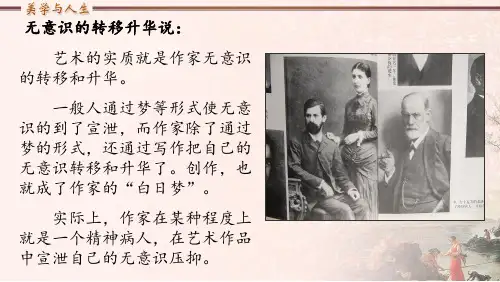
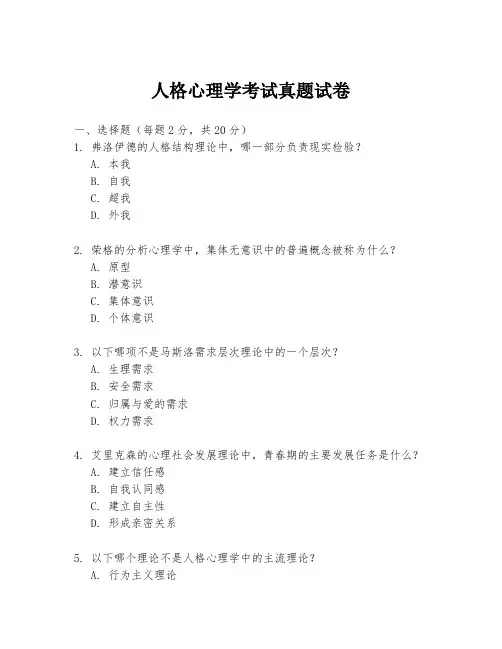
人格心理学考试真题试卷一、选择题(每题2分,共20分)1. 弗洛伊德的人格结构理论中,哪一部分负责现实检验?A. 本我B. 自我C. 超我D. 外我2. 荣格的分析心理学中,集体无意识中的普遍概念被称为什么?A. 原型B. 潜意识C. 集体意识D. 个体意识3. 以下哪项不是马斯洛需求层次理论中的一个层次?A. 生理需求B. 安全需求C. 归属与爱的需求D. 权力需求4. 艾里克森的心理社会发展理论中,青春期的主要发展任务是什么?A. 建立信任感B. 自我认同感C. 建立自主性D. 形成亲密关系5. 以下哪个理论不是人格心理学中的主流理论?A. 行为主义理论B. 认知理论C. 人本主义理论D. 心理分析理论6. 根据大五人格理论,以下哪个特质不是大五人格的维度之一?A. 开放性B. 责任心C. 外向性D. 情绪稳定性7. 阿德勒的个体心理学中,哪个概念用来描述人们追求优越的心理动力?A. 自卑感B. 社会兴趣C. 优越性D. 动力性8. 以下哪个选项不是人格特质的测量工具?A. 明尼苏达多项人格问卷(MMPI)B. 16种人格因素问卷(16PF)C. 艾森克人格问卷(EPQ)D. 韦克斯勒智力量表(WISC)9. 根据奥尔波特的人格理论,以下哪个概念用来描述人格的独特性?A. 特质B. 动机C. 个性D. 态度10. 以下哪个理论强调了人格的稳定性和一致性?A. 情境主义B. 交互主义C. 行为主义D. 特质理论二、简答题(每题10分,共30分)1. 简述弗洛伊德的人格结构理论,并说明本我、自我和超我各自的功能。
2. 描述荣格的集体无意识理论,并解释原型是如何影响个体行为的。
3. 解释马斯洛的需求层次理论,并讨论其在现代人格心理学中的应用。
三、论述题(每题25分,共50分)1. 论述艾里克森的心理社会发展理论,并结合实际例子说明个体在不同阶段可能遇到的危机。
2. 讨论大五人格理论在组织行为学中的应用,以及它如何帮助我们更好地理解个体在工作环境中的行为。
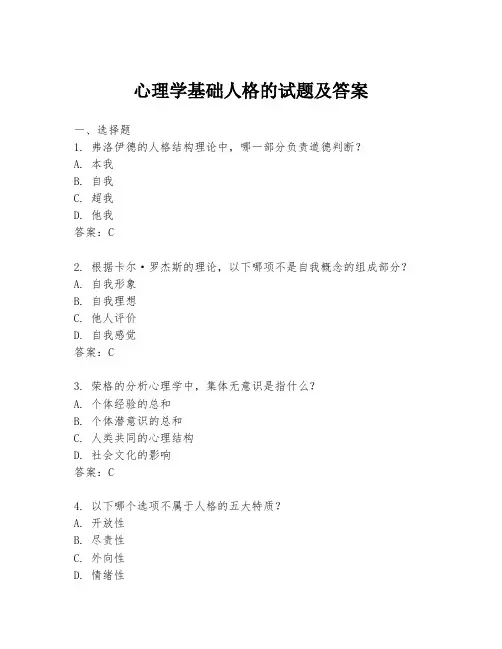
心理学基础人格的试题及答案一、选择题1. 弗洛伊德的人格结构理论中,哪一部分负责道德判断?A. 本我B. 自我C. 超我D. 他我答案:C2. 根据卡尔·罗杰斯的理论,以下哪项不是自我概念的组成部分?A. 自我形象B. 自我理想C. 他人评价D. 自我感觉答案:C3. 荣格的分析心理学中,集体无意识是指什么?A. 个体经验的总和B. 个体潜意识的总和C. 人类共同的心理结构D. 社会文化的影响答案:C4. 以下哪个选项不属于人格的五大特质?A. 开放性B. 尽责性C. 外向性D. 情绪性答案:D5. 根据艾森克的人格理论,神经质高的人倾向于:A. 情绪稳定B. 情绪不稳定C. 社交能力强D. 社交能力弱答案:B二、判断题1. 人格是个体行为和心理特征的总和。
(对)2. 人格特质理论认为人格是由几个基本维度构成的。
(对)3. 弗洛伊德的人格结构理论中的本我遵循现实原则。
(错)4. 荣格认为人格发展是一个自我实现的过程。
(对)5. 艾森克的人格维度包括外向性、神经质和开放性。
(错)三、简答题1. 简述弗洛伊德的人格结构理论。
答案:弗洛伊德的人格结构理论包括三个部分:本我、自我和超我。
本我是人格结构中最原始的部分,遵循快乐原则;自我是现实原则的代表,调节本我和超我之间的冲突;超我是道德原则的代表,内化社会规范和道德标准。
2. 描述荣格的人格类型理论。
答案:荣格的人格类型理论基于两种态度(外倾和内倾)和四种功能(思维、情感、感觉、直觉)。
这些类型组合起来形成八种不同的人格类型,每种类型都有其独特的特点和行为模式。
四、论述题1. 论述人格发展的影响因素。
答案:人格发展是一个复杂的过程,受到多种因素的影响,包括遗传、环境、文化、教育、社会互动和个人经历等。
遗传因素为人格提供了生物学基础,而环境因素则在个体成长过程中塑造人格特质。
文化背景影响个体的价值观和行为规范,教育和家庭环境对个体的人格发展具有深远的影响。

荣格的集体无意识理论浅析( A brief analysis of Carl Jung'scollective unconsciousness theory )A brief analysis of Carl Jung's collective unconsciousness theory2007141057 Zhou ChaofengAbstract: the main contents of collective unconsciousness are various archetypes. Prototype, in fact, is the basic mode of psychological activity, it is the vestige of human ancient social life, and the accumulation and enrichment of typical experience that people repeat hundreds of millions of times in social life. Manis an image inherited from his ancestors, which inherits the same innate tendency of grasping the world and reflecting the same as his ancestors. This predisposition is inherited from brain tissue from generation to generation.Carl Jung attaches great importance to the study of archetype, and tries to reveal the hidden unconscious behind the consciousness, especially the collective unconscious secret through the study of the prototype. There are many archetypes of collective unconscious, but the most important ones are the archetypes, namely, the Pers ona, Anima (anima) and Arnim J (animus), f (theshadow) and sel (the).Key words: collective unconsciousness; Carl Jung; archetypal instinctText:The human mind is a very complex and fascinating world, great achievements of Freud is he bravely into the deep areas of the world, reveals the deep secret consciousness in this world. His successors, the Swiss psychologist Carl Jung, is on the basis of Freud, deep into the deeper areas of the human mind, deeper into the field of the collectiveunconscious of the humanmind, discusses the collective unconscious of the human heart the deepest secret.First, the concept of collective unconsciousnessCarl Jung's great ideological system is based on the theory of collective unconsciousness, so what is collective unconsciousness?We know that people's psychological activities can be divided into two levels of consciousness and unconsciousness, actually unconscious mental activity can be divided into two levels: the first level is the unconscious Freud said, it is associated with the individual life experience of not being aware of the psychological activities, such as forget the memories, unpleasant experiences, repressed desire and motive etc.. The unconscious is called individual unconsciousness; in contrast, in the humanunconscious and part is beyond the individual life experience acquired is not dependent on personal experience and the existence of a beyond the individual and even the nation, race is commonin all humanbeings and collective psychological activity, this is the collective unconscious.The collective unconscious is a deeper unconscious, refers to the individual human ancestors inherited from the inheritedcommon unconscious psychological elements, similar to the instinct, restrict and promote the role of individual behavior and social civilization, namely when the scene and some ancestors experienced roughly the same. This factor will be activated and play a role as innate pattern, act like ancestors react to things around, as people often on dark, snakes have an innate sense of fear and does not need to be acquired experience, because of the formation of our ancestors in the long-termlife experience of darkness and snake fears to us, this is a manifestation of the collective unconscious. It is the common ancestors of generations of human experience, through repeated accumulation, accumulation, and concentration, concentration, mental content in the form of a trace buried in the brain structure, is a part of the brain structure, is a part of human psychology, is hereditary left to the universal spirit the function, in the final analysis, is the common congenital tendency, reflecting the schema.Before Carl Jung, people's knowledge of unconsciousness remained at the first level. Only through the discovery of Carl Jung did people make a great leap forward in the realization of the unconscious. The discovery of collective unconsciousness is undoubtedly another milestone contribution in the history of psychological development. It makes people realize that there is someconsistency in humanspiritual life, which may be the basis of humansympathy. From the perspective of collective unconsciousness, human beings are integrated in the spiritual depths. Collective unconsciousness is hardly ever realized in human life,But it will profoundly affect individual and social behavior.Two. The background of collective unconsciousnessAs a theory of the formation and development, there is a certain social, scientific, subjective and other background, formation and development of Carl Jung's theory of the collective unconscious, also have their own particular social and historical background.First, Freud's psychoanalytic psychology. Among the many factors that influence Carl Jung's theory of collective unconsciousness, Freud's psychoanalysis should be the first one, and Carl Jung himself is outspoken. Carl Jung is based on Freud's study, uses his unconscious theory, adopted the method of Psychoanalysis (analytical method, themethod of free association, dream and self analysis), the research field of psychoanalysis, a step forward.Second, social background. Carl Jung's era is the era of great development of human civilization, the common progress of material civilization and spiritual civilization, so that human face the reality, began to reflect on the past, explore the true meaning of humansoul. Therefore, the social and time factors play a very important role in Carl Jung's thought and research.Third, the scientific and philosophical background. Since nineteenth Century, the humanities and social sciences have been greatly developed, such as life science, culturology, anthropology, etc.. At that time the Lamarckian inheritance of acquired characteristics, namely the predecessor learns through experience things, do not need to re learn can be left to future generations, habits gradually became instinct; Darwin's theory of biological evolution and widely spread, Carl Jung's high school and college life is spent in this atmosphere. He not only inherited the Lamarckian inheritance of acquired character theory, and the absorption of Darwin's natural selection theory of evolution, both not only provides specific ideas for Carl Jung, and also provided psychiatric research phenomenon and psychological phenomenon for his theory.Fourth, personal subjective factors. Freud and A De's theory of music can not be separated from their personal subjective factors and life experience. Carl Jung's collective unconscious theory can not be separated from his personal subjective factors. Carl Jung's parents' marriage, feelings of distorted shadows, limbo difficult family life, he created the character of loneliness, introversion, self-confidence, emotion rich, that made him pay more attention to subjective world and various inner mysterious body face and dream on. The investigation in the depthof Africa was the first time he exposed the primitive mentality of the primitive nation, and had a personal experience of the primitive people's mentality and collective unconsciousness.Fifth, occupational factors. Carl Jung's occupation for him also has great significance, it not only provides a lot of opportunities for contact with him and study the collective unconscious, but he analyzed a lot of dreams, fantasies, empathy phenomenon,access to the collective unconscious of the truth.Three, the content of collective unconsciousnessThe main contents of collective unconsciousness are various archetypes. Prototype, in fact, is the basic mode of psychological activity, it is the vestige of human ancient social life, and the accumulation and enrichment of typical experience that people repeat hundreds of millions of times in social life. Manis an image inherited from his ancestors, which inherits the same innate tendency of grasping the world and reflecting the same as his ancestors. This predisposition is inherited from brain tissue from generation to generation. Carl Jung called the "original image" or "ghost heart", the physiological structure as we have many ancestors traces, so our psychological structure. The development of human psychology is actually the process of consciousness rising and expanding from collective unconsciousness.Carl Jung attaches great importance to the study of archetype, and tries to reveal the hidden unconscious behind the consciousness, especially the collective unconscious secret through the study of the prototype. There are many archetypes of collective unconsciousness, and Carl Jung believes that there are many archetypes in how many typical situations there are in life". He found many prototypes in his own research,Such as birth, death and regeneration of the prototype prototype prototype, prototype, prototype, God demonold wise man, the hero archetype prototype, prototype of mother earth and many natural objects such as the sun, the moon prototype prototype prototype, wind, water and fire prototype, and there are manycreations such as weaponssuch as prototype prototype, but the most important is four the prototype, namely the persona (the Pers ona), Anima (anima) and Arnim J (animus), the shadow (theshadow) and the self (the sel f).The persona that people can play a social role, innate tendencies conform to the society expectations, it ensures that people can show some personality in order to adapt to the society, this is not the real character of personality, but its side publicly displayed, its purpose is to make a good impression to get social recognition. Persona is necessary for human existence. It ensures people can get along well with others and achieve personal goals. But the excessive development of personality mask will suppress people's real personality and nature, and even lose themselves.Anima and Arnim J are the opposite of the opposite sex in man's psychology. The former is the female side of the male psychology, while the latter is the male side of the woman's psychology.Every man has a female image in the depth of his unconscious, which affects his attitudes towards women. This image is not a specific woman, but only a vague and uncertain about the female form, it is the day after tomorrow and individual life gradually get women experience especially initial experience together will form his concept of women.The prototype of Nimes is just the opposite. The existence of these two archetypes tells us that each person is born with some nature of the opposite sex. Psychologically, each person's mind is a mixture of the sexes. These two archetypes will profoundly influence people's attitudes towards theopposite sex and ways of communication. For example, when people are looking for love, they are often looking for the opposite sex of Anima or Nimesarchetype. In case of love at first sight, a man or a woman to see each other from the heart feel the other side is looking for love and even a kind of deja vu intimacy, this is no consciousness of Anima or Nimes, the prototype is activated. The prototype of Anima and Nimes helps people better understand and communicate with the opposite sex, but their excessive development may lead to sexual confusion or even heterosexual.Shadowis a prototype that represents a person's own gender and affects his relationship with the same sex. It is one of the oldest and most primitive archetypes of human beings, and it is also the most powerful and dangerous one, more than any other prototype. Onthe one hand, the shadowis full of life vitality, passion and creativity, contains the most valuable intuitive wisdom for human beings, on the other hand the shadow and accommodatethe human"evil", such as aggressive, destructive, so it is the people all the best and worst of the East West birthplace. Whenthe persona of an overly strong and weaken the power of the shadow, people will live a dull, lack of passion and creativity of the pale life, and if the shadow of severely repressive society or society can not provide appropriate vent channels, often lead to collective disaster. Behind every large-scale war or social upheaval, there is a huge shadow behind it. This may be the tragedy of civilization. To understand this, we may understand why large-scale war and be brutal and inhuman for thousands of years of humanhistory, the most destructive massacre happened not barbarism tribes but had highly civilized people, why go to the human civilization and progress, but more frequent and brutal war.The prototype of self is the most central prototype in collective unconsciousness, which shows that the humanspirit or personality has a congenital organizational principle and a tendency toward wholeness, which is a prototype of unity, organization and order,All other prototype and manifest these archetypes in consciousness and complex are attracted to it around (the so-called complex, is found, another important psychology Carl Jung certain behavior refers to the relatively independent personality unit or psychological tendency, formed by the combination of a series of related experience can influence and control or for some the event, attitude) so that they are in a state of harmony, the unity of personality. This is the ultimate goal of the development of human spirit.The above four archetypes are the most important archetypes in human beings, which determine the way people grasp the world and react to various life events. The strength and strength of various archetypes are different in human beings. Some archetypes are too powerful and often constrain the development of other archetypes, such as the repression of the persona to the shadow. In addition, different archetypes can be combined with each other, thus changing the personality. This is also one of the fundamental reasons for the difference between people.Four, collective unconscious manifestationCollective unconsciousness exists in the deepest and lowest level of humanspiritual life, so it is difficult to be realizedin human life. But it can still manifest itself in individuallife and social culture in various forms. The following is a brief talk about the basic manifestation of collective unconsciousness.First of all, it can be shown in fairy tales and fairy tales.Myth is the true portrayal of the primitive humanconsciousness in the Enlightenment period, when the human consciousness was just born out of unconsciousness, and the unconscious force was still very strong and directly affected the consciousness of mankind. Therefore, primitive and unsophisticated myths, which are not processed by later generations, are often the direct manifestation of humanunconsciousness, especially collective unconsciousness.Second, collective unconsciousness can manifest itself through human dreams. Dreams are a window into the unconscious. The content of dreams is the direct manifestation of unconsciousness, including collective unconsciousness.In addition, collective unconsciousness may also manifest itself in some schizophrenic patients. Schizophrenia is actually the disintegration of a state of consciousness that causes the unconscious content to flow out and dominate the individual's personality and behavior without any hindrance, and there are many collective unconscious contents.These are the typical and direct manifestations of collective unconsciousness, but the collective unconscious is in various forms. It exists in every corner of human social life, for example in ancient ethnic and tribal culture and traditional ceremonies, in various works of literature and art, religionand ritual in the symbol of every hue on there are generationsof oral communication and so on, we can find the collective unconsciousness hidden in the depths of its shadow. Each person's soul and the whole social culture.Five. The significance of collective unconsciousnessThe concept of collective unconsciousness refers to the"independent spirit", which is beyond the material determinism and opposed to the hypothesis of the soul",Is not out of the flesh but the inherent spiritual instinct.He extended the unconscious from the individual to the collective, and pushed the collective unconscious source to the spiritual remains of the ancient race. Because Carl Jung couldn't find a better place than the hypothesisTo explain the collective unconscious phenomenon scientifically without deviating from the principle of his independent spirit. Ad locumNor can Freud describe this collective phenomenon as a consequence of the traumatic experience acquired from the day after tomorrow, for exampleIn this way, collective unconsciousness is also an acquired spiritual reflection related to experience, which is very unfavorable to both of themThe establishment of psychology based on the independent spirit of opposing the spirit of the soul and against the spirit ofmaterial determination. So, he's got to be toughThe collective unconsciousness is the common and unconscious structure of human nature, not the psychological function. Emphasis on human unconsciousnessThe deep layer reveals the inborn instinct and behavior pattern of human beings, and finds an important position for the irrational factors of human beingsThe unconscious is the deepest of all human conscious activities,The last, most important decision. It has a modern WestThe basic tendency of humanism with the characteristics of irrationalism.Carl Jung overcame the limitations of Freud's theory and combined psychological research with social factors and historical and Cultural StudiesHad manymajor theoretical innovation. For Carl Jung's theory, many accused him of adding to the mystery of PsychoanalysisMost people generally agree that Carl Jung's theory is the cradle of many primitive concepts. In the field of psychoanalysis, he has direct influenceAnd inspired his followers. They inherited and developed the main ideas of Carl Jung's psychology, especially his views onarchetype,And the formation of a post Carl Jung school with extensive international influence has become a major force in Contemporary Western psychotherapy. andMoreover, Carl Jung's influence is not confined to the field of psychoanalysis. As a matter of fact, Carl Jung is paid more attention to in the prevailing postmodern trend of thought.Collective unconsciousness profoundly influences individuals and society. For individuals, the collective unconscious is our spiritual wealth of ancient ancestors, it determines our view of the world, understand theworld and a variety of responses to the ways of the world; for the society, the collective unconscious is the source of every kind of the spirit of the times, any kind of spirit of the times, whether it is good or bad, no it should be a collective consciousness in a prototype. Whenmost of the people in the community are in the collective unconscious, some archetypes are activated, and people will show some highly consistent behavior and ideas, which constitutes a certain spirit of the times. The development of individual and society is also influenced by collective unconsciousness. The prototype of self may makethe individual go towards the maturity and perfection of personality, and make the society towards harmony and unity, but in the process, there is also the danger of destruction or even destructive influence by other archetypes, such as shadow. Who is the final winner, only history can answer? From this point of view, the fate of human beings is in the hands of their own, and the answer lies in the deepest spirit of the law that we know today. Therefore,recognizing the existence of collective unconsciousness and its significance is undoubtedly of positive significance to the development of human beings themselves. As a old saying "you the fate of the stars in your own heart, indeed, the deepest secrets are hidden from all human unconscious.Reference :1, Yang Yanping, on the collective unconsciousness in Carl Jung's aesthetic theory system, Journal of Liuzhou Teachers College, June 2009, twenty-fourth volume, third2, Hu Fan, analysis of Carl Jung's collective unconsciousness, Journal of Pingxiang College, 2003, second;3, Lv Kai, on collective unconsciousness and its performance, Journal of Guangxi Institute of education, 2003, first;4, Adel Tail, Carl Jung's collective unconscious theory andJack London's call of the wild, Journal of Henan NormalUniversity (PHILOSOPHY AND SOCIAL SCIENCES EDITION), 2000 second;5, Dai Guibin, Carl Jung collective unconscious review, Journal of Hubei Radio and TV University, 1999 third;6, Shi Desheng and Carl Jung's theory of collective unconsciousness and its formation background, Journal of Qinghai University for Nationalities (SOCIAL SCIENCESEDITION), second issue of 1994;7, Zhou Yiqi, Li Min, Carl Jung "synchronic" rule analysis, Nankai sociological review, 2003;8, Lu Qingzhong, WangFang, an interpretation of "Yi" and "Tao" -- Also on Carl Jung's synchronic law, Zhongzhou journal, November 2000 SixthA brief analysis of Carl Jung's collective unconsciousness theoryZhouchaofengTwo billion seven million one hundred and forty-one thousand and fifty-seven 2010.01.03。

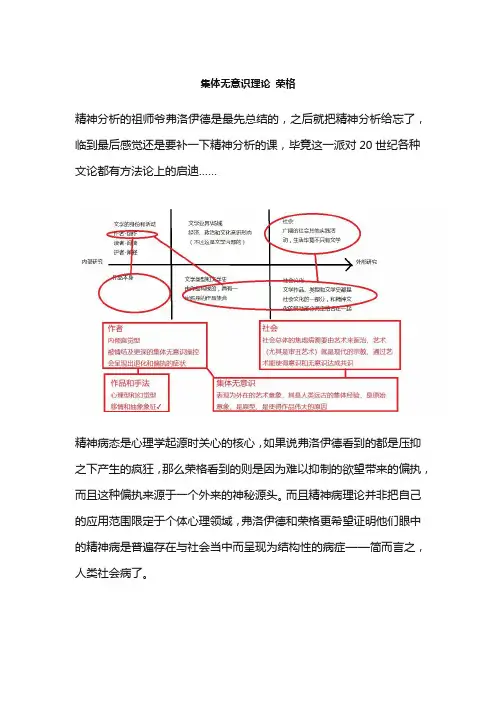
集体无意识理论荣格精神分析的祖师爷弗洛伊德是最先总结的,之后就把精神分析给忘了,临到最后感觉还是要补一下精神分析的课,毕竟这一派对20世纪各种文论都有方法论上的启迪……精神病态是心理学起源时关心的核心,如果说弗洛伊德看到的都是压抑之下产生的疯狂,那么荣格看到的则是因为难以抑制的欲望带来的偏执,而且这种偏执来源于一个外来的神秘源头。
而且精神病理论并非把自己的应用范围限定于个体心理领域,弗洛伊德和荣格更希望证明他们眼中的精神病是普遍存在与社会当中而呈现为结构性的病症——简而言之,人类社会病了。
荣格本来和弗洛伊德保持着多年的好朋友,但他逐渐对弗洛伊德强调性动机的理论产生了怀疑,最终这种怀疑发展为对弗洛伊德力比多=原始性欲观点的公开反对。
荣格认为力比多直接解释成抽象的心理力量就好,何必把它和性挂钩,于是俩人儿就闹掰了——荣格难受了整整三年,然后站起来说qtmd弗洛伊德,老子单干了,之后自己建了一套理论,其中集体无意识这个概念影响颇大,比如著名朴素思想——也就是,naive ——文论家弗莱就是荣格的拥趸。
不过荣格本人对艺术的看法是非常神秘的,他有一套自圆其说的艺术创作理论,虽然这套理论的大体框架被后世不少文论家接纳,但其具体观点充满了对文艺扭曲的理解。
|荣格的人格结构和人格类型理论荣格认为人格是一个整体,被称为精神,是具有原始统一性的,其包括自我、个体无意识还有集体无意识三个部分。
自我就是我们自觉到的部分,其构成了意识域的中心,使人格能够在时间流中保持自我同一。
除去自我以外,精神中还有无意识部分,其中个人经历过的却被压抑隐藏的经验是个体无意识,更深层的无意识是与生俱来的,来自于人类作为一个集体在历史进程中的集体经验,是一种超越个性的心理基础。
弗洛伊德的无意识理论指强调个体经历,这在荣格看来是不够深入的。
个体无意识中提供动力的机制是情结,它是一组相互关联的观念和思想,有力地驱使人的思想和行为。
情结会造成人的偏执,但这种偏执不全是坏事,其有可能成为灵感的源泉。
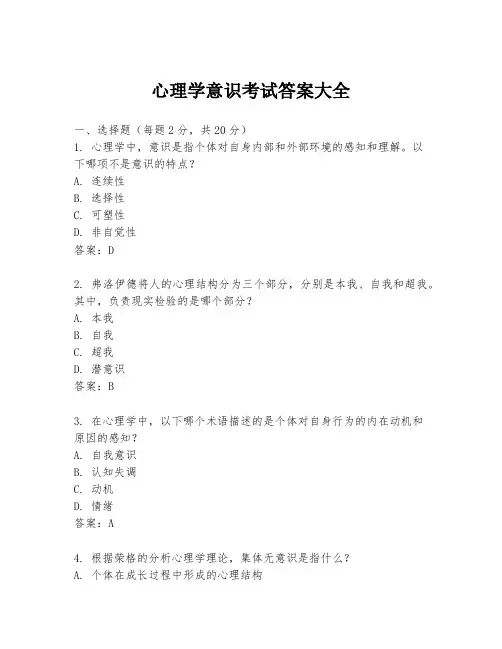
心理学意识考试答案大全一、选择题(每题2分,共20分)1. 心理学中,意识是指个体对自身内部和外部环境的感知和理解。
以下哪项不是意识的特点?A. 连续性B. 选择性C. 可塑性D. 非自觉性答案:D2. 弗洛伊德将人的心理结构分为三个部分,分别是本我、自我和超我。
其中,负责现实检验的是哪个部分?A. 本我B. 自我C. 超我D. 潜意识答案:B3. 在心理学中,以下哪个术语描述的是个体对自身行为的内在动机和原因的感知?A. 自我意识B. 认知失调C. 动机D. 情绪答案:A4. 根据荣格的分析心理学理论,集体无意识是指什么?A. 个体在成长过程中形成的心理结构B. 个体潜意识中的共同心理内容C. 个体意识中的共同心理内容D. 人类共有的意识答案:B5. 心理学中的“自我实现”是指个体追求什么的过程?A. 满足基本生理需求B. 实现个人潜能和自我发展C. 追求社会地位和财富D. 获得他人的认可和赞许答案:B6. 以下哪个理论是由卡尔·罗杰斯提出的?A. 行为主义理论B. 精神分析理论C. 人本主义理论D. 认知行为理论答案:C7. 在心理学中,认知失调理论是由哪位心理学家提出的?A. 弗洛伊德B. 马斯洛C. 费斯廷格D. 罗杰斯答案:C8. 心理学中的“自我效能感”是指个体对自己完成特定任务的能力的信念。
这一概念是由哪位心理学家提出的?A. 班杜拉B. 马斯洛C. 罗杰斯D. 弗洛伊德答案:A9. 以下哪个选项不是情绪智力的组成部分?A. 情绪识别B. 情绪调节C. 情绪表达D. 情绪抑制答案:D10. 心理学中的“认知重评”是指个体如何改变对情绪事件的认知和解释,以调节情绪反应。
这一概念是由哪位心理学家提出的?A. 拉扎勒斯B. 艾利斯C. 贝克D. 梅耶答案:A二、简答题(每题10分,共30分)1. 描述意识流的概念及其在心理学研究中的意义。
意识流是指个体在一段时间内连续不断、变化多端的意识体验。
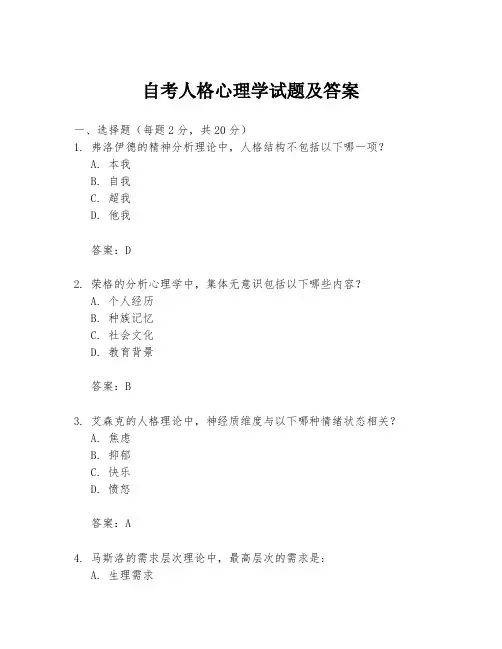
自考人格心理学试题及答案一、选择题(每题2分,共20分)1. 弗洛伊德的精神分析理论中,人格结构不包括以下哪一项?A. 本我B. 自我C. 超我D. 他我答案:D2. 荣格的分析心理学中,集体无意识包括以下哪些内容?A. 个人经历B. 种族记忆C. 社会文化D. 教育背景答案:B3. 艾森克的人格理论中,神经质维度与以下哪种情绪状态相关?A. 焦虑B. 抑郁C. 快乐D. 愤怒答案:A4. 马斯洛的需求层次理论中,最高层次的需求是:A. 生理需求B. 安全需求C. 社交需求D. 自我实现需求答案:D5. 根据大五人格理论,以下哪一项不是大五人格的维度?A. 开放性B. 责任心C. 外向性D. 情绪稳定性答案:D6. 卡尔·罗杰斯的自我理论中,自我概念不包括以下哪一项?A. 自我理想B. 自我现实C. 自我评价D. 他人评价答案:D7. 根据埃里克森的心理社会发展理论,青少年期的主要发展任务是:A. 建立信任B. 自我认同C. 亲密关系D. 生成自我答案:B8. 根据弗洛姆的人格理论,以下哪种人格类型不是逃避自由的方式?A. 权威主义B. 破坏性C. 创造性D. 市场性答案:C9. 根据阿德勒的个体心理学,以下哪一项不是阿德勒认为的人格发展的关键因素?A. 社会兴趣B. 优越性C. 家庭环境D. 个人努力答案:B10. 根据人格心理学,以下哪一项不是人格的特质?A. 稳定性B. 独特性C. 可塑性D. 遗传性答案:D二、简答题(每题10分,共30分)1. 简述弗洛伊德的精神分析理论中的防御机制有哪些,并举例说明。
答案:弗洛伊德的精神分析理论中的防御机制包括压抑、投射、否认、合理化、转移等。
例如,压抑是指个体将不愉快的想法或感受从意识中排除,如一个人可能压抑对亲人的愤怒。
2. 描述大五人格理论的五个维度,并简要说明每个维度的含义。
答案:大五人格理论的五个维度包括开放性、责任心、外向性、宜人性和神经质。
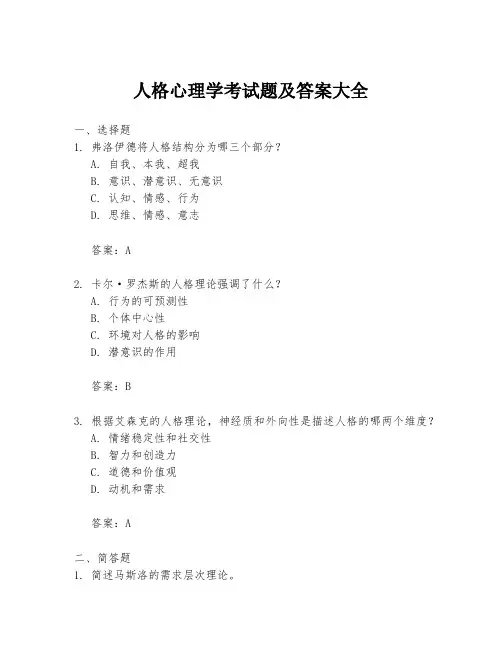
人格心理学考试题及答案大全一、选择题1. 弗洛伊德将人格结构分为哪三个部分?A. 自我、本我、超我B. 意识、潜意识、无意识C. 认知、情感、行为D. 思维、情感、意志答案:A2. 卡尔·罗杰斯的人格理论强调了什么?A. 行为的可预测性B. 个体中心性C. 环境对人格的影响D. 潜意识的作用答案:B3. 根据艾森克的人格理论,神经质和外向性是描述人格的哪两个维度?A. 情绪稳定性和社交性B. 智力和创造力C. 道德和价值观D. 动机和需求答案:A二、简答题1. 简述马斯洛的需求层次理论。
答案:马斯洛的需求层次理论认为人的需求可以分为五个层次,从低到高依次是生理需求、安全需求、社交需求、尊重需求和自我实现需求。
这些需求是按照一定的顺序满足的,只有当较低层次的需求得到满足后,人们才会追求更高层次的需求。
2. 描述荣格的集体无意识理论。
答案:荣格的集体无意识理论认为,人类共享一个深层的、普遍的心理结构,称为集体无意识。
这个结构包含了人类共同的经验和象征,如原型。
原型是集体无意识中的普遍模式,影响着我们的行为和思维方式。
三、论述题1. 论述人格心理学在现代心理咨询中的应用。
答案:人格心理学在现代心理咨询中的应用非常广泛。
首先,它帮助咨询师更好地理解来访者的个性特点和行为模式。
其次,人格理论可以作为诊断工具,帮助识别来访者可能的心理问题。
此外,人格心理学还可以指导咨询师选择适合来访者的咨询方法和技术,提高咨询效果。
四、案例分析题1. 假设一个案例,一个高中生因为成绩下滑而感到焦虑和压力,使用人格心理学理论分析其可能的原因,并提出相应的咨询建议。
答案:该高中生可能因为完美主义倾向(如艾森克的人格理论中的神经质维度)而对成绩有过高的期望,导致焦虑。
咨询师可以采用罗杰斯的无条件积极关注,帮助学生认识到成绩不是自我价值的全部,鼓励学生探索自我,发展自我接纳和自我效能感。
同时,可以教授学生一些压力管理技巧,如时间管理、放松训练等。
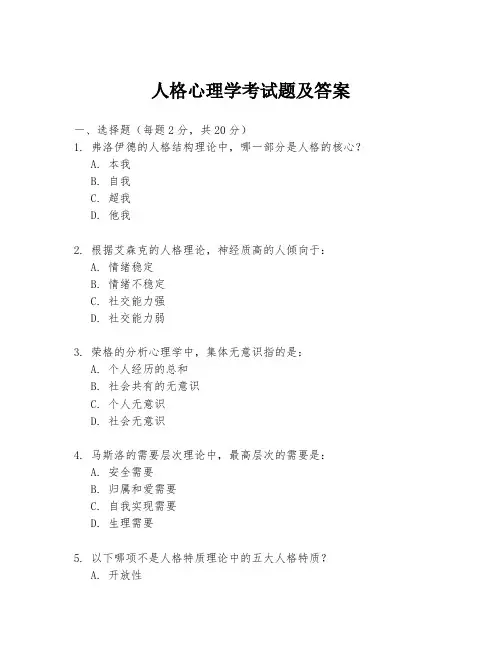
人格心理学考试题及答案一、选择题(每题2分,共20分)1. 弗洛伊德的人格结构理论中,哪一部分是人格的核心?A. 本我B. 自我C. 超我D. 他我2. 根据艾森克的人格理论,神经质高的人倾向于:A. 情绪稳定B. 情绪不稳定C. 社交能力强D. 社交能力弱3. 荣格的分析心理学中,集体无意识指的是:A. 个人经历的总和B. 社会共有的无意识C. 个人无意识D. 社会无意识4. 马斯洛的需要层次理论中,最高层次的需要是:A. 安全需要B. 归属和爱需要C. 自我实现需要D. 生理需要5. 以下哪项不是人格特质理论中的五大人格特质?A. 开放性B. 责任心C. 外向性D. 情绪性6. 根据大五人格理论,以下哪项特质与领导力相关性最高?A. 外向性B. 责任心C. 开放性D. 宜人性7. 人格障碍通常是指:A. 人格特质的极端表现B. 人格特质的平均水平C. 人格特质的缺失D. 人格特质的多样性8. 以下哪项不是人格发展的影响因素?A. 遗传B. 环境C. 教育D. 年龄9. 根据艾里克森的心理社会发展理论,青春期的主要危机是:A. 信任与不信任B. 自我同一性与角色混乱C. 勤奋与自卑D. 亲密与孤独10. 以下哪项不是人格测量的方法?A. 问卷调查B. 行为观察C. 心理测试D. 星座分析答案:1-5 A B B C D6-10 A B A B D二、简答题(每题10分,共30分)1. 简述弗洛伊德的人格结构理论。
2. 描述艾森克的人格维度理论,并解释其与人格特质的关系。
3. 解释马斯洛的需要层次理论,并举例说明。
三、论述题(每题25分,共50分)1. 论述人格心理学在现代心理咨询和治疗中的应用。
2. 讨论人格特质与职业选择之间的关系,并给出实例。
结束语:人格心理学是心理学的一个重要分支,它涉及到对个体差异的深入研究。
通过本考试题,我们不仅考察了学生对人格心理学基本概念和理论的掌握,还考察了他们对这些理论在实际生活中的应用能力。
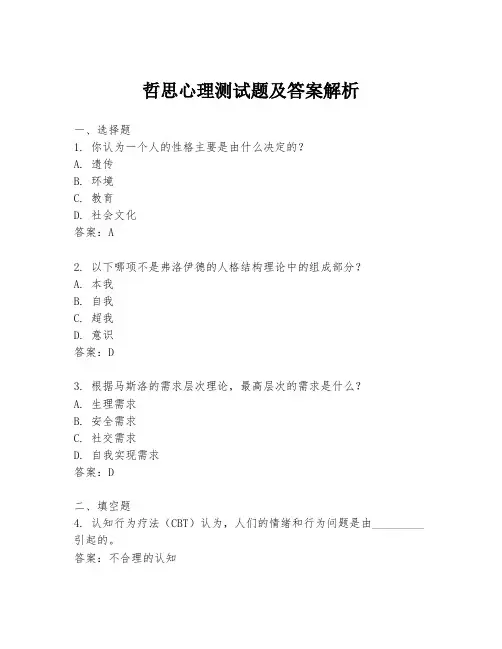
哲思心理测试题及答案解析一、选择题1. 你认为一个人的性格主要是由什么决定的?A. 遗传B. 环境C. 教育D. 社会文化答案:A2. 以下哪项不是弗洛伊德的人格结构理论中的组成部分?A. 本我B. 自我C. 超我D. 意识答案:D3. 根据马斯洛的需求层次理论,最高层次的需求是什么?A. 生理需求B. 安全需求C. 社交需求D. 自我实现需求答案:D二、填空题4. 认知行为疗法(CBT)认为,人们的情绪和行为问题是由_________引起的。
答案:不合理的认知5. 卡尔·罗杰斯提出的“无条件积极关注”是指在心理治疗过程中,治疗师应该对来访者持有_________的态度。
答案:接纳和理解三、简答题6. 简述荣格的集体无意识理论。
答案:荣格认为集体无意识是人类共有的、遗传的心理结构,它包含了人类祖先的经验,这些经验以原型的形式存在于我们的潜意识中。
7. 描述一下艾瑞克森的心理社会发展阶段理论。
答案:艾瑞克森的心理社会发展阶段理论认为,人的心理发展是一个逐渐成熟的过程,分为八个阶段,每个阶段都有其特定的发展任务和危机,个体需要成功解决每个阶段的危机,才能顺利过渡到下一阶段。
四、论述题8. 论述弗洛伊德的梦的解析理论。
答案:弗洛伊德认为梦是潜意识欲望的满足,是潜意识与意识之间的桥梁。
梦的解析理论包括显梦和隐梦两个部分,显梦是梦的表面内容,隐梦是梦的深层意义。
通过自由联想和象征解释,可以揭示梦的隐意,从而了解个体的潜意识冲突和欲望。
五、案例分析题9. 假设你是一名心理咨询师,你的来访者小李最近经常做恶梦,他梦到自己被困在一间着火的屋子里,无法逃脱。
请分析小李的梦境可能反映了什么心理问题,并提出相应的咨询建议。
答案:小李的梦境可能反映了他对当前生活或工作压力的恐惧和焦虑,被困在着火的屋子里可能象征着他感到自己处于一种无法控制的困境中。
作为心理咨询师,可以建议小李进行放松训练,学习压力管理技巧,并探讨其现实生活中可能存在的问题,帮助他找到解决问题的方法。
精神实战测试题及答案解析一、单项选择题(每题2分,共20分)1. 精神分析学派的创始人是:A. 弗洛伊德B. 荣格C. 阿德勒D. 马斯洛答案:A2. 下列哪项不是精神分析理论中的防御机制?A. 压抑B. 投射C. 升华D. 认知答案:D3. 根据弗洛伊德的理论,梦的解析中,梦的显性内容是:A. 梦的表面故事B. 梦的隐藏意义C. 梦的预兆D. 梦的启示答案:A4. 精神分析理论中,自我防御机制的目的是:A. 满足欲望B. 减少焦虑C. 增强自我D. 获得快乐答案:B5. 荣格的分析心理学中,“集体无意识”是指:A. 个人经验的总和B. 社会文化的共同记忆C. 个体潜意识的集合D. 人类共有的潜意识答案:D6. 阿德勒的个体心理学认为,人类行为的主要动力是:A. 性本能B. 自我实现C. 权力欲望D. 社会兴趣答案:D7. 马斯洛的需求层次理论中,最高层次的需求是:A. 生理需求B. 安全需求C. 归属与爱的需求D. 自我实现需求答案:D8. 根据弗洛伊德的理论,儿童发展的哪个阶段与肛门有关?A. 口腔期B. 肛门期C. 性器期D. 潜伏期答案:B9. 精神分析理论认为,潜意识中的冲突和欲望可以通过以下哪种方式表达?A. 梦境B. 行为C. 言语D. 艺术创作答案:A10. 荣格的分析心理学中,人格发展的主要动力是:A. 个体化B. 自我实现C. 社会适应D. 集体无意识答案:A二、多项选择题(每题3分,共15分)1. 以下哪些是精神分析理论中的关键概念?A. 自我B. 本我C. 超我D. 潜意识答案:ABCD2. 弗洛伊德认为,梦的解析可以通过以下哪些方法?A. 联想B. 象征C. 投射D. 直接解释答案:ABC3. 阿德勒的个体心理学中,以下哪些因素影响个体的行为?A. 生物因素B. 社会因素C. 心理因素D. 文化因素答案:ABCD4. 荣格的分析心理学中,以下哪些是人格发展的关键阶段?A. 儿童期B. 青春期C. 成年期D. 老年期答案:ABCD5. 马斯洛的需求层次理论中,以下哪些需求属于缺失需求?A. 生理需求B. 安全需求C. 归属与爱的需求D. 自我实现需求答案:ABC三、判断题(每题1分,共10分)1. 弗洛伊德认为,梦是愿望的达成。
荣格分析心理学的基本理论(一)集体无意识集体无意识既是对弗洛伊德个体潜意识的发展,也是荣格的一种创造,荣格用它来表示人类心灵中所包含的共同的精神遗传。
荣格自己在给集体无意识做定义的时候,曾经这样说:“集体无意识的是精神的一部分,它与个体潜意识截然不同,因为它的存在不像后者那样可以归结为个人经验。
因此不能为个人所获得。
构成个人无意识的主要是一些我们曾经意识到,但以后由于遗忘或压抑而从意识中消失的内容;集体无意识从来就没有出现在意识之中,因此也就从未为个人获得,它们的存在完全得自于遗传。
(二)原型荣格的原型概念与其集体无意识概念的关系十分密切。
正如他所曾明确表达的那样,个人潜意识与各种情绪的构成有关,而集体无意识的内容则主要是原型。
荣格说:“原型是人类原始经验的集结,它们像命运一样伴随着我们每一个人,其影响在我们每个人的生活中感觉到。
”集体无意识是通过某种形式的继承或进化而来,是由原型这种先存的形式构成,原型赋予某些心理内容以独特的形式,集体无意识具有普遍的表现方式,它组成了一种超个人的心理基础,普遍地存在于我们每个人身上,并且会在意识及无意识的层次上,影响着我们每个人的心理和行为。
(三)原型意象荣格用原型意象来描述原型将自身呈现给意识的形式,但荣格也一直努力区分原型与原型意象的不同,原型本身是无意识的,我们的意识无从认识它,但是可以通过原型意象来理解原型的存在及其意义。
于是我们可以把原型意象看作是原型的象征性表现。
无意识内容一旦被觉察,它便以意象的象征形式呈现给意识。
象征的物质成分使意识处于激活状态,意识受到象征的激活,而把兴趣指向象征,并力求去理解它。
这就是说,象征除了“能量转换者”的动力学作用之外,也是“意识塑造者”。
它迫使心理去同化象征中所包含着的一种或多种无意识内容。
同时,由于原型及原型意象总是具有其集体无意识的渊源,因而一旦将这些理论运用在实际的临床心理分析的过程中,实际上就是在利用集体无意识原型以及原型意象本身所包含的治愈功能与作用,在这种意义上,意象、象征与想象,也就成为荣格心理分析中最重要的方法与特色。
荣格集体无意识【摘要】“集体无意识”是心理学中的一个重要理论,在艺术创作中也具有重要的意义,它是解读人类审美心理、艺术欣赏心理的钥匙。
本文分别从概念、结构组成以及在艺术创作中的重要意义做了详细的论述,并提出了艺术创作应符合受众群的“公共艺术无意识”的创作原则。
【关键词】无意识集体无意识艺术创作“集体无意识”是由瑞士心理学家、哲学家荣格提出来的。
荣格是分析心理学的奠基者弗洛伊德的学生,也是分析心理学的创始人之一。
荣格发展了佛洛伊德的无意识理论,将无意识具体地区分为:误差无意识、病患无意识、梦幻无意识、本能无意识、习惯无意识及集体无意识。
按照荣格的话说,“集体无意识”是指“有史以来沉淀于人类心灵底层的、普遍共同的人类本能和经验遗存”,这遗存既包含了人类先天的生理学意义上的遗存,也包含了人类后天的社会生活意义上的遗存。
在荣格之前,弗洛伊德就已提出了“无意识”这一概念,但这种纯心理学意义的“无意识”只是一种“个性”,或者更准确地说,它只是客观个体的一种意识属性。
正因为如此,“无意识”理论仅仅只可能用于研究客观个体的无意识行为,例如“释梦” [弗洛伊德将梦认为是人在无意识状态下(梦中)“愿望的满足” ]及对精神病人进行“心理治疗”(医生可以从病人的习惯行为中找到习惯无意识,再按照他或她的习惯无意识就可探索他或她的心理病因,最后可采取相应的心理治疗方法)。
而“集体无意识”的提出在心理学发展史上可以说是一次里程碑式的伟大成就,它第一次将心理学从纯个性化的研究中解放出来,将心理学引入了广阔的人类学领域、社会学领域以及一切意识形态领域(哲学、伦理学、美学、艺术学、宗教……)。
就艺术理论而言,“集体无意识”是解读人类审美心理、艺术欣赏心理的钥匙,完全可以有理由说,如果不理解“集体无意识”就很难将美学和艺术学置于坚实的地基之上。
简单地说,无意识就是一种“没有意识到的意识”,或者说是一种“不自觉的意识”,人们常常也将其称为“潜意识”。
集体潜意识集体潜意识示例“集体潜意识”是人格结构最底层的无意识,包括祖先在内的世世代代的活动方式和经验库存在人脑中的遗传痕迹。
集体无意识和个人无意识的区别在于:它不是被遗忘的部分,而是我们一直都意识不到的东西。
荣格曾用岛打了个比方,露出水面的那些小岛是人能感知到的意识;由于潮来潮去而显露出来的水面下的地面部分,就是个人无意识;而岛的最底层是作为基地的海床,就是我们的集体潜意识。
概念荣格突出心理结构的整体性,提出“ 集体潜意识”等概念。
他也认为人格结构由三个层次组成:意识(自我)、个人潜意识(情结)和集体潜意识(原型),这和弗洛伊德的提法有所不同。
个人潜意识“个人潜意识”是人格结构的第二层,作用要比意识大。
它包括一切被遗忘的记忆、知觉和被压抑的经验,以及梦和幻想等。
荣格认为个人无意识的内容是情结。
情结往往具有情绪色彩,是一组一组被压抑的心理内容聚集在一起而形成的无意识丛,如恋父情结、批评情结、权力情结等。
个体无意识是一个容器,蕴含和容纳着所有与意识的个体化机能不相一致的心灵活动和种种曾经一时是意识经验,不过由于各种各样的原因受到压抑或遭到忽视的内容,如令人痛苦的思想、悬而未决的问题、人际间冲突和道德焦虑等等。
还有一些经验,它们与人们不甚相干或显得无足轻重,由于本身强度太弱,当人们经历它们时达不到意识层,或者不能留驻在意识之中,因而都被贮藏在个体无意识里。
所有这些构成了个人无意识的内容,当需要时,这些内容通常会很容易地到达意识层面。
集体潜意识“集体潜意识”是荣格理论中最大胆的、最神秘的、并引起最大争议的概念。
理解集体潜意识就理解了同各理论的最核心部分。
集体潜意识反映了人类在以往的历史演化进程中进程中的集体经验,或者用荣格本人的话来说,它是"一种不可计数的千百年来人类祖先经验的成绩,一种每以实际仅仅增加极小极少变化和差异的史前社会生活经验的回声"(荣格1928,第162页)不仅全部人类历史的各个片断能在极其潜意识中找到,而且进化为人类的灵长类动物或动物祖先的踪迹也能在集体潜意识中发现。
荣格集体无意识理论综述作者:王磊来源:《科教导刊·电子版》2017年第31期摘要卡尔.古斯塔夫·荣格(Cral.Gustav.Jung,1875-1961)的思想体系是以集体无意识为核心建立起来的,荣格把人类的心理活动可以分为三个层次即意识、个人无意识、集体无意识。
荣格的集体无意识的核心是原型(或原始意象),原型,是心理活动的基本模式,其通过脑组织世代相传。
集体无意识的原型很多,但其中最重要的是五种原型,即人格面具(the Persona)、阿尼玛(anima)和阿尼姆斯(animus)、阴影(the shadow)和自身(the self)。
关键词荣格集体无意识本能原型中图分类号:J01 文献标识码:A0引言一个理论的形成和发展总有一定的社会、科学、哲学以及其他的背景,否则就是无根之木,无源之水。
集体无意识理论的形成和发展也是在受到当时特定社会宗教科学哲学的影响而建立。
1荣格集体无意识理论产生的背景1.1弗洛伊德的精神分析学说在弗洛伊德的理论中把人格结构分为潜意识、前意识、和意识来描述人格,虽然后期把人格分为本我、自我、和超我,但不论其对人格结构如何划分,他始终认为意识不重要,意识只代表整个人格的外显方面,潜意才最为重要的,人的大量的想法、观念、愿望等,以及不能被社会道德所接受的被压抑的性的本能即是人的潜意识。
人的心理就像漂浮于海面上的冰山,露在水面上的只是一小部分,即各种意识到的心理活动;而藏在冰山底下无法意识到的绝大部分属于潜意识。
弗洛伊德看来,潜意识是生物性本能的仓库;是一种被压抑的强大的内驱力;是人类一切活动的动力源泉,其根据对梦的分析、失言、精神官能症等来研究潜意识的本质,并指出其在行为中的重要作用;潜意识是人格中最初级、最简单、最低级、最基本的因素;潜意识主要是以性为中心的各种本能,其绝大部分是从未意识到。
而荣格关于集体无意识的理解是指在漫长的历史演变过程中人类祖先世代积累经验;人类对某些事件做出特定反应的先天遗传的倾向。
1、精神分析批评的核心是( 2 分)A.文学文本B.潜意识C.读者D.作者A 参考答案 B2、成为中国现代印象主义批评领军人物的是( 2 分)A.周作人B.李健吾C.朱光潜D.沈从文参考答案 B3、把格式塔心理学引进文艺领域,用来解释视知觉艺术的是( 2 分)A.弗洛伊德B.拉康C.韦特默D.阿恩海姆参考答案 D4、印象批评认为从整体上领悟作品精妙的最好方式是( 2 分)A.逻辑分析B.审美直觉C.条分缕析D.单项深入参考答案 B5、用“磨刀石”比喻文学批评对文学创作作用的是( 2 分)A.柏拉图B.亚里士多德C.贺拉斯D.朗吉努斯参考答案 C6、文学批评准备工作的第一项是( 2 分)A.研读B.选题C.立意D.运思参考答案 A7、在现代心理学史上提出所谓“意识流”主张的是( 2 分)A.冯特C.弗洛伊德D.荣格参考答案 B8、把文学艺术创作活动看成是“原始欲望升华”的是( 2 分)A.冯特B.詹姆斯C.弗洛伊德D.荣格参考答案 C9、古罗马文学评论家贺拉斯用来归结文学批评对文学创作作用的比喻是( 2 分)A.绊脚石B.风景石C.磨刀石D.试金石参考答案 C10、图像化的深层实质是信息表达和接受上的( 2 分)A.理性化B.理论化C.感觉化D.条理化参考答案 C11、文学批评家的想象力主要表现为一种艺术的( 2 分)A.欣赏力B.理解力C.领悟力D.推想力参考答案 D12、用“敏锐的诗意感觉”来说明批评感知的是( 2 分)A.黑格尔B.别林斯基C.席勒D.普列汉诺夫参考答案 B13、本雅明的理论建树主要在与他对( 2 分)A.“文化霸权”问题的研究 B.“机械复制时代的艺C.“大众工业”问题的研究D.“大众传媒”问题的研究参考答案 B14、与文学作品的政治、道德评价不同,审美价值判断的第一个层面是( 2 分)A.社会政治判断B.道德判断C.传递美感D.理智判断参考答案 C15、印象派一词跟《日出·印象》系列绘画有关,该画的作者是( 2 分)A.莫奈B.雷阿诺C.柏格森D.叔本华参考答案 A16、文学批评的意识形态功能突出表现在文学批评的( 2 分)A.经济价值B.政治倾向C.审美倾向D.哲学价值参考答案 B17、印象主义思潮首先出自 19 世纪中期的印象主义( 2 分)A.音乐派别B.雕刻派别 C.绘画派别 D.文学派别参考答案 C18、文学批评家的审美感知力首先表现为( 2 分)A.语感 B.结构感 C.意象感 D.美感参考答案 A19、文学批评的意识形态功能突出表现在文学批评的( 2 分)A.审美判断 B.政治倾向 C.意义阐释 D.道德教育参考答案 B20、把文学艺术创作活动看成是“白日梦”的是( 2 分)A.冯特 B.詹姆斯 C.弗洛伊德 D.荣格参考答案 C 多项选择题21、社会历史批评的评判尺度包括( 2 分)A.科学性 B.客观性 C.真实性 D.社会效果 E.倾向性参考答案 CDE22、19 世纪俄罗斯三大民主主义批评家是指( 2 分) A.别林斯基B.车尔尼雪夫斯基 C.费尔巴哈D.杜勃罗留波夫E.普列汉诺夫参考答案 ABD23、文学批评由于善于吸收当今文学批评的最新发展,因此其方法论的特征表现为( 2 分)A.统一性B.开放性C.多声部D.单一性E.共同性参考答案 BC24、丹纳明确提出影响文学生产和发展的三个因素是( 2 分)A.自然B.种族C.环境D.历史E.时代参考答案 BCE25、文学批评写作中的复述的基本要求包括( 2 分)A.体认文眼诗魂B.只讲述故事梗概C.综合段落大意D.传达原作神E.抓住全文线索参考答案 ADE名词解释26、大众文化( 5 分)参考答案具有都市化色彩(区别于乡村色彩的民间文化)、商业性的(不是自发的、也基本不是官方染指的)、渗透于日常生活的(不同于经典文化那种神圣性质)、具有感性冲击力的(不是说教的)一种在当代社会具有影响力的、在大众生活中有广泛影响的文化。
引言《格林利夫》(1956)是弗兰纳里·奥康纳的著名短篇,1957年获得欧·亨利奖。
半个世纪以来,关于这个故事,国外评论界已从宗教、神话、解构主义等视角做过一些的评论,如,小詹姆斯·A·格利姆沙(James A.Grimshaw,Jr.)认为《格》讲述的是一个宗教救赎的故事①(53-54);约翰·戴斯蒙德(John Desmond)从解构主义视角分析奥氏旨在使原本处于边缘地位的格林利夫一家中心化②(68);苏珊·莫娄·保罗逊(Suzanne Morrow Paulson)基于神话原型探析《格》中隐喻的男、女二元对立③(40-45)。
不仅如此,我国学者也对该小说进行一些很有见地的评论,如罗婷研究《格》中妇女蜕变的苦难历程④(160);张燕借助女性主义批评理论,剖析二战后奥氏眼中的女性社会地位⑤(64-66)。
本文拟用荣格心理学深入文本,剖析梅太太生存状况及死亡的心理层面,寻找《格》中的荣格集体无意识理论痕迹。
梅太太:阿尼玛与阿尼玛斯对立的人格面具《格》围绕南方某农场主梅太太(Mrs.May)与雇工格林利夫(Greenleaf)一家以及她与儿子们的冲突展开。
梅太太是个寡妇,她经营着一个农场。
一天一头公牛闯进了她的奶牛场并且毁坏了她家的树篱,为了弄清这头公牛的来历并设法将它赶出去,梅太太和一直跟她作对的格林利夫发生了激烈的冲突;此外,梅太太和自己的两个儿子也因处理这头公牛的事而大动干戈。
愤怒之下,梅太太不得不亲自带上枪去射杀那头公牛。
结果牛没被杀死,梅太太自己却被那头狂奔而来的公牛用犄角顶死。
心理学大师荣格(Jung)指出人类的心理是双性的,即男性心理中有女性特征,称为阿尼玛(Anima);同时,女性心理中也有男性特征,称为阿尼玛斯(Animus)。
阿尼玛和阿尼玛斯是男性与女性在长期交往的过程中所产生的,它给男性提供女性气质,给女性提供男性气质;同时,它也提供一个指导男性与女性交往的参照系。
此外,荣格认为异性的心理特征总是处于无意识状态,属于本我的范畴,由于受到超我的压制、自我的监督,通常在人们展示出的人格面具中不易被觉察到。
⑥(181-182)梅太太生活在一个农场里,整天与男性打交道,看不到女性色彩。
丈夫死后,为了一家人的生存,梅太太更是辛勤劳作,把农场打理得井井有条,试图取代已故的丈夫,承担起男人的职责和义务。
在支撑家业的过程中,在与她的两个儿子,她的雇工格林利夫及其两个儿子的长期交往过程中梅太太渐渐成了一位生活方式男性化的寡妇。
她总是“把她的脊背挺得像耙柄似的”(引文出处见该书,以下只标注页码)⑦(49);在林中走路时,她总是带着一根长棍(49)。
甚至在梦中,“每走一步,她都将她的棍子插在自己面前”(70)。
按照心理学理论,耙柄和长棍是男性力量的象征。
显然,由于周围环境与生活同伴的影响,梅太太的阿尼玛原型渐渐缺乏,阿尼玛斯意识在她的心理渐趋形成一种强势的本我,蠢蠢欲动。
接受了阿尼玛斯男性意识,梅太太便极力压抑自己的阿尼玛女性特征,将自己纳入男性角色《格林利夫》中荣格的集体无意识理论痕迹冯宜丽域外小说研究181贰零壹零年第贰期的行为规范中。
她开始同大多数男性一样,将功成名就、家业兴旺看作人生头等大事。
为了获得成功,她经历了无数的酷暑严寒,克服了无数的艰难困苦,辛勤地耕耘着那块贫瘠的土地。
15年来梅太太“一直不停地在工作”(64),“使一个濒临破产的农场重新焕发了生机”(54)。
梅太太经营的农场日渐成功,她的阿尼玛女性特征也日渐消失,原本还处在无意识层的阿尼玛斯得到极大的发展。
目前,家业成了她的命根子,农场成了她骄傲的资本。
当她的朋友称赞她是个像男人一样了不起的女人时,她显得非常自得,以至于“从房间的任何一个窗户看去,她都能看见自己的影子”(54)。
显然,梅太太对男性力量的渴求已经融化到她的意识之中,变成她灵魂的内核。
然而,梅太太也时常“感到疲惫、厌倦”(64)。
这时,梅太太的阿尼玛女性意识犹存,只是为了两个儿子,她的本我不得不把阿尼玛女性气质隐藏起来。
梅太太:死亡的心理诠释通过对看似无声却胜有声的格林利夫一家、文中所提及的那头牛以及性格大相庭径的儿子们与梅太太之间的矛盾表现,梅太太性格中的愤懑不平、嫉妒和偏执被刻画得淋漓尽致。
梅太太不仅生活上表现出强势的阿尼玛斯男性意识,心理上也自觉不自觉地模仿着男权社会中男性普遍具有的罪恶劣的角色特征——控制欲。
《格》中梅太太对格林利夫的控制欲决不亚于任何一个男人。
文学评论家弗莱里克·阿萨尔斯也曾说,奥氏笔下人物的控制欲,最终表现为急不可耐地将自我投射到外部世界中,以使现实生活符合他们心中的精神生活,并特别提及《格》中的梅太太。
[8](126)当她碰见他时,梅太太总觉得自己精力旺盛,无处发泄,“仿佛受到了魔鬼的挑战,所有的力量重新回到她的身上”(60)。
“驾驭他成了她的第二天性”(52),并以能够控制他而自鸣得意。
在教训两个儿子时,她说:“这么多年来,要不是我踩着他的脖颈,你们两个宝贝也许早就大清早四点钟起来挤牛奶了。
”(54)不仅如此,梅太太还企图控制自己的死亡。
她说:“当我一切准备妥当时,我才会死。
”(54)她甚至想控制她的后事:她到她的律师那儿,限定了她的遗产继承权,规定她的两个儿媳妇无权继承她的遗产(49)。
她还恨不得在她死后禁止她的两个儿子继续雇佣格林利夫(51)。
这时,梅太太的阿尼玛女性意识处于崩溃的边缘,取而代之的是阿尼玛斯男性意识。
梅太太花了整整15年的时间与格林利夫周旋,她自以为她有能力制服格林利夫,但事实却恰恰相反,格林利夫从没有停止同她的明争暗斗。
而且,梅太太每次瞧见他时总觉得“他从某个无形的圈子外向她走来”(47)。
奥康纳用圈子的意象暗示梅太太控制格林利夫的最终失败。
梅太太阿尼玛斯原型的再度强化也正是由于她驾驭格林利夫的失败而致。
格林利夫形式上是梅太太的雇工,实际上是她的对头。
他总是仰仗自己是个男人而经常偷懒,对梅太太的吩咐常常表现出一副漫不经心、阳奉阴违的态度,还时不时跟她较劲儿。
例如当梅太太把她两个不成器的儿子吹嘘为成功的知识分子和商人时,格林利夫从不像仆人似地随声附和,反而还不失时机地显摆一下自己的儿子。
梅伊太太对外竭力抗争,做出了巨大的牺牲,为的是给两个儿子营造舒适的生活环境。
可是她的两个儿子不仅无心经营农场,还对寡母的感受漠不关心,常常在她面前摆出一种“居高临下”的姿态。
他们的模样与奥康纳的另一部短篇《发冷不已》(1958)中那个对母亲放肆、专横的阿什伯瑞相比毫不逊色。
奚落、抱怨更是家常便饭。
大儿子斯哥费尔德不仅在语言上蔑视母亲,而且跟她说话时总是“哼着小曲儿”。
一次,因为生活中的不如意,梅伊太太在饭桌上数落两个儿子不关心和不帮忙时,小儿子威斯利极为不恭地奚落母亲,甚至激起了大儿子的强烈不满。
斯哥费尔德嘲着威斯利大叫大吵,兄弟俩大打出手,弄得饭厅里碗盘摔碎,桌椅翻到。
在这些嘈杂的声响下,梅伊太太缺乏男性的关爱,也缺乏做女性的安全。
丈夫的去世,格林利夫的挑衅,儿子的不争气使梅伊太太本我中的男性心灵意象如脱缰的野马,彻底失去超我的约束。
梅伊太太公布于众的人格面具已经不再是女性气质,而是完完全全的男性气质翻版;集结在梅伊太太心理的这种以阿尼玛斯原型为摹本的男性情结是梅伊太太人格面具的主要内容,也是她在精神上和社会上饱受孤立之苦的根源。
一次,格林利夫故意让他儿182子的公牛(男性象征)闯进梅太太的奶牛场(女性象征),啃嚼她家的树篱。
格林利夫的蓄意捣毁使梅太太心中的阿尼玛原型再次受到极大的威胁,她梦见公牛“正在吞噬她和她的两个儿子,……把一切都吃光了,只剩下格林利夫一家安逸地居住在原来属于她家的农场上”(69)。
这梦折射了梅太太阿尼玛女性的焦虑,也进一步强化了她的阿尼玛斯男性意识:她不能坐以待毙,也不相信“对付一个女人你可以不费吹灰之力”(61)。
梅太太命令格林立夫立刻把他的公牛关起来,而格林利夫根本不把梅太太的命令当回事。
最后,愤怒的梅太太不得不拿上枪,决定亲自射杀那头公牛。
在她和公牛最后遭遇之前,她感到“命令得到执行带给她的欢欣”(68),她甚至不能自抑,“欢快地说:‘春天来啦!’”(68)。
此时,梅太太的阿尼玛彻底消失,阿尼玛斯原型极度膨胀,心理强势的男性意识彻底冲破前意识的检查,来到意识层,外化成她标标准准的男性人格面具。
从上述的分析中,我们清晰地看到梅太太的悲剧是意味深长的。
它说明奥氏,作为一名天主教女性作家,对二十世纪五六十年代的女权主义运动有着独特的见解。
奥氏清醒地意识到女性的阿尼玛斯男性无意识如果失去超我的压制、自我的监督,势必会被过度强化,外显成男性化的女人,难以实现真正的自我,也难逃个人命运的悲剧。
梅太太正是这样的女性。
丈夫的去世,格林利夫的挑衅,儿子的不争气使梅太太本我中的阿尼玛斯男性无意识如脱缰的野马,彻底失去超我的约束。
梅太太公布于众的人格面具已经不再是女性的阿尼玛特征,而是完完全全的阿尼玛斯原型翻版;集结在梅太太心理的以阿尼玛斯原型为摹本的男性情结是梅太太本我无意识的主要内容,是她饱受孤立之苦的精神根源。
结语文学评论的方法和角度多种多样,每一种方法和角度揭示文本不同的层面。
从荣格的集体无意识理论去解读《格》,读者可以发现,奥氏是在通过自己的小说,深层次地展示妇女对二十世纪五六十年代女权主义运动的内心矛盾。
这一种深度,可能更靠近奥康纳创作的高度,即从根本上、从深层次去解读女性的社会人格面具,而不是仅仅给读者讲述一个女性饱受孤立之苦、悲惨命运的故事。
基金项目:2009年河南省教育厅青年基金项目2009QN025。
项目名称:弗兰纳里·奥康纳小说的精神分析研究及启示冯宜丽河南机电高等专科学校外语系参考文献:①Grimshaw,James A.The Flannery O’Connor Companion[M].Westport:Greenwood Press,1981.②Desmond,John F.Risen Sons:Flannery O’Connor’s Vision of History[M].Athens and London:the University of Georgia Press,1987.③Paulson,Suzanne Morrow.Flannery O’Connor-A Study of the Short Fiction[M].Boston:Twayne Publishers,1988.④罗婷.现代美国妇女的困境与自救——论当代美国女性小说[J].外国文学研究,1994(1).⑤张燕.《格林立夫》:弗兰纳里·奥康纳对女性问题的思考[J].洛阳师范学院学报,2003(3).⑥Guerin,Wilfred L.A Handbook of Critical Approaches to Literature[M].Peking:Foreign Language Teaching and Research Press,2005.⑦O’Connor,Flannery.Everything That Rises Must Converge[M].New York:A Signet Book,The New American Library,1965.⑧O’Connor,Flannery.The Imagination of Extremity[M].Georgia:University of Georgia Press,1982.域外小说研究183。